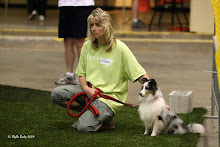
What is the best exercise for your dog. Off leash hiking. I try to hike with my dogs but not off leash. I know off leash is better because they use more and different muscles to run around and jump over things. But this park is the best I can do and it has to be on leash. At least there are lots of roots and up and down hills to help with muscle building and propre0ception.
Just a side note I read in my notes. One dog going through the weaves on the video was double footing through the poles but stayed on the left lead every time instead of switching leads. So what was wrong with the right leg?
Jumping: Dogs should extended their front legs and use their rear legs for thrust. As the dog jumps, first his head is up and his back end ( tail) is down. After he reaches the apex of the jump, his head is down and his tail is up. This information helps you by being able to use the "head up and tail down" to see if your dog took off to soon or too late. So if he hasn't gone over the bar but his tail is down, then you know he is probably going to knock the bar. Dogs that are over jumping the bar ( clearing the bar with lots of room under them) are taking off too soon. But there are a few dogs that just love to jump and jump way high. Your dog may have a physical problem if the are refusing the jumps, taking off too close or landing to hard on the front.
She teaches dogs to jump by putting about 20 bars on the ground at different withs to each other. Then she has them go down the middle of the bars. We did this at the seminar for dogs that didn't do agility so they didn't have jumping experience. Someone would hold the dog at the end. The owner would walk down the middle of the poles and turn around and call the dog to them. If the dog went around, the owner would start over and stop in the middle of the poles ( only go down to pole 10) and turn around an call the dog. As the dogs got more successful , the poles would be adjusted. By putting cans under one end of the poles, or both ends, or making the poles diagonal ( two poles touched ends on the side). It was interesting to see the dogs start to learn to adjust there strides as they went through the poles. She states this teaches them where their take off points are in relation to the poles. You are to keep this very fun and there are no corrections to be given to your dog if they go around the poles or make any mistakes. They are just thinking and just trying to figure things out. Give treats when they do it right.
Next we did lead legs. This group of dogs had experience jumping. The dogs did different things like going down three jumps, then 2 jumps and turn 180. This was all to see dogs change lead legs. I had a very hard time seeing dogs change there lead legs. Miley looked like she was using both front legs to land on, but Chris said it just looked that way because she was so little. But actually the one leg was coming down before the other. We had the dogs do a sequence where there was a pinwheel on each end and you were to front cross in between pinwheels to turn the dog. If a dog waits until the very last second to change lead, this could be a single that the dog has an injury. Miley did very well with all the jump sequences. Everyone was very impressed even Chris. She asked me if I was going for the World Team. I told her I'm just trying to get to my first trial. She also said she hoped she wasn't going to be competing against me at the trials. After the seminar a bunch of people came up to me and said what a great dog I had. One guy even said, " I wish I had your dog, she is great" So of course that made me feel great! Don't worry I'm well aware that I have a long way to got with training. All I have to do is go to some other peoples blogs and watch their dogs run. That keeps things in perspective. But it was still nice to hear.
3 most common injuries:
1. Medial shoulder instability. This happens more in dogs with straight shoulders.
2. Iliososoas (sp) strain . This is the most common agility injury
3. Jump down syndrome. You shouldn't let your dogs jump in and out of SUV's or vans. This injury can not be seen on any scans. You have to have arthroscope to see it. This injury tends to happen in dogs with short humerus. Its like having elbow dysplasia. It cant really be fixed to the point of your dog returning to competition.
Some of this info today I did from memory because I didn't have anything written down. It was hard to right and do and watch at the same time. Over all I learned alot and recommend her seminar. It was good to be able to asked questions. I really hope she will do a seminar on the stuff on agility obstacles and your dogs performance. The only thing was it was hard on Miley to be in the crate so much. Probably and older dog would do better. When we were going through structure and gaits, I wish I had brought Guiness. But there was another sheltie there that had been clipped. She shaved her under side but still had her top and chest coat. Well, Chris kinda gave her a hard time about cutting the dogs coat. She really feels the coat insulates the dog from the heat. So at that time, I was glad I didn't bring Guiness. He is shaved for the summer. She would have really given me a hard time. I think for some dogs that shaving there coat makes them deal much better with the heat here in South Carolina. Last night it was still 95 degrees at 7 pm. Plus the humidity is usually 95%. Sometimes it feels like you cant breath when you go outside.
Lastly, Miley is at the vet getting spayed. I'm nervous. Ive only had male dogs in the past and their procedure is pretty easy. Roxy was already spayed when I got her. So this will be my first experience with a female. Lets face it, the spay is harder than a neuter. They have to open the abdominal cavity and remove multiple organs. At least this vet gives pain medication to take home with your dog. Keep your fingers crossed.






No comments:
Post a Comment